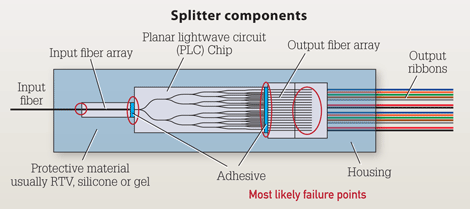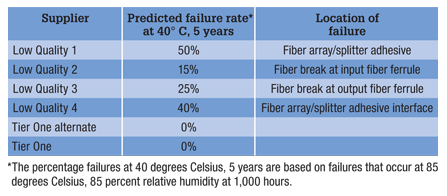Corning Cable Systems Ray Barnes and Dave Eckell, passive optical LAN (POL) solutions managers, present their research into the failure points of a low-quality splitter. This post will provide an overview of the educational article which delves into the construction of splitters, likely points of failure, testing procedures for reliability, and cost of failure.

During the past four years, interest in the passive optical LAN (POL) has steadily increased for multiple reasons. In new construction projects, a LAN operator may see up to 50 percent savings by installing a POL solution instead of the traditional LAN solution. This number includes the total installed cost of electronics and structured cabling. The POL solution also provides a reduction in power consumption and is a lower-cost alternative that meets the bandwidth needs of today's LAN environment.
One key aspect of the network infrastructure which cannot be overlooked is reliability. Barnes and Eckell explain, "for the POL, the optical splitter is essentially the heart of the network. The splitter allows a single POL port on the optical line terminal (OLT) to serve many optical network terminals (ONT) and an even greater number of users that will be connected through each ONT. This is the real value of an enterprise POL, and this value is only realized if the optical splitter is reliable, tested and designed to perform without degradation or failure for the life of the enterprise POL installation."
The increase in POL interest has increased the number of POL manufacturers, including those which are of especially poor quality. Low-quality splitters may be faulty and unreliable. These low-quality splitters are often sold as an un-branded product at a fraction of the cost of a reputable optical splitter online with little information as to the origin or qualification testing.

Corning testing of optical splitters has shown that this component is more sensitive to failures than typical LAN optical components such as connectors and optical cabling due to the internal complexity of the assembly. Therefore, when it comes to using optical splitters in the LAN, it is especially important to consider performance, warranty and reliability in choosing which product to purchase. The initial savings will be minor when factoring in the downtime, troubleshooting and repair costs associated with recovering from a failed optical splitter.
For more information, continue reading the Corning article.


.png?width=58&height=58&name=X_logo_2023_(white).png)
